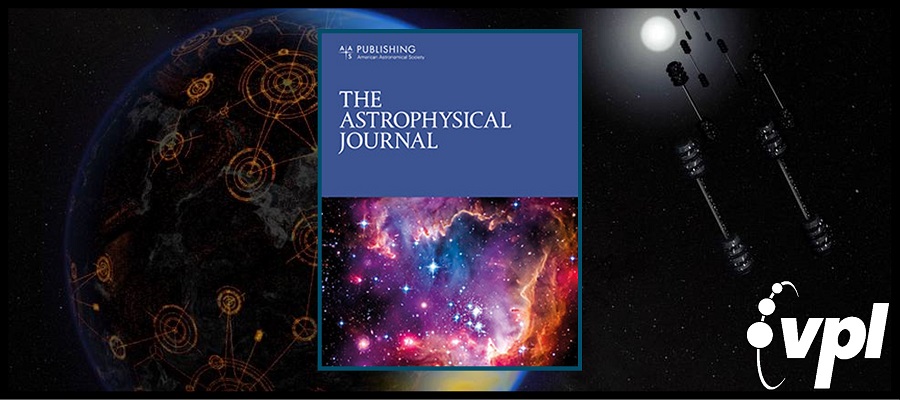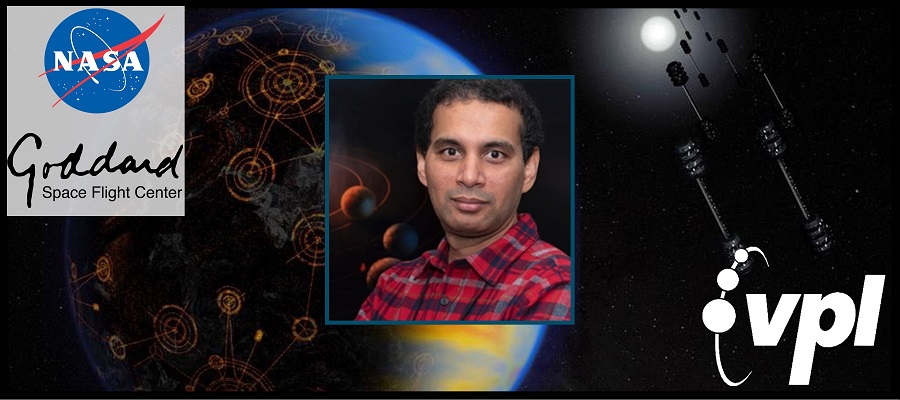VPL Team members Ravi Kopparapu, Giada Arney, Jacob Haqq-Misra, and Jacob Lustig-Yaeger, recently submitted a new study for publication exploring…
Here we use a 3‐D climate system model to study the habitability of Earth‐like planets orbiting in circumbinary systems. In the most extreme cases, Earth‐like planets in circumbinary systems could experience variations in the incident stellar flux of up to ~50% on ~100‐day timescales. However, we find that Earth‐like planets, having abundant surface liquid water, are generally effective at buffering against these time‐dependent changes in the stellar irradiation due to the high thermal inertia of oceans compared with the relatively short periods of circumbinary‐driven variations in the received stellar flux.
VPL Scientist Dr. Jacob Haqq-Misra (BMSIS) was recently featured on the Ask an Astrobiologist program! You can watch a recording…
The search for spectroscopic biosignatures with the next generation of space telescopes could provide observational constraints on the abundance of exoplanets with signs of life. An extension of this spectroscopic characterization of exoplanets is the search for observational evidence of technology, known as technosignatures. Current mission concepts that would observe biosignatures from ultraviolet to near-infrared wavelengths could place upper limits on the fraction of planets in the Galaxy that host life, although such missions tend to have relatively limited capabilities of constraining the prevalence of technosignatures at mid-infrared wavelengths. Yet searching for technosignatures alongside biosignatures would provide important knowledge about the future of our civilization. If planets with technosignatures are abundant, then we can increase our confidence that the hardest step in planetary evolutionthe Great Filteris probably in our past. But if we find that life is commonplace while technosignatures are absent, then this would increase the likelihood that the Great Filter awaits to challenge us in the future.
Planets that revolve around a binary pair of stars are known as circumbinary planets. The orbital motion of the stars around their center of mass causes a periodic variation in the total instellation incident upon a circumbinary planet. This study uses both an analytic and numerical energy balance model to calculate the extent to which this effect can drive changes in surface temperature on circumbinary terrestrial planets. We show that the amplitude of the temperature variation is largely constrained by the effective heat capacity, which corresponds to the ocean?to?land ratio on the planet. Planets with large ocean fractions should experience only modest warming and cooling of only a few degrees, which suggests that habitability cannot be precluded for such circumbinary planets. Planets with large land fractions that experience extreme periodic forcing could be prone to changes in temperature of tens of degrees or more, which could drive more extreme climate changes that inhibit continuously habitable conditions.
We use a one-dimensional (1D) cloud-free climate model to estimate habitable zone (HZ) boundaries for terrestrial planets of masses 0.1 ME and 5 ME around circumbinary stars of various spectral type combinations. Specifically, we consider binary systems with host spectral types F-F, F-G, F-K, F-M, G-G, G-K, G-M, K-K, K-M and M-M. Scaling the background N2 atmospheric pressure with the radius of the planet, we find that the inner edge of the HZ moves inwards toward the star for 5 ME compared to 0.1 ME planets for all spectral types. This is because the water-vapor column depth is smaller for larger planets and higher temperatures are needed before water vapor completely dominates the outgoing longwave radiation. The outer edge of the HZ changes little due to competing effects of the albedo and greenhouse effect. While these results are broadly consistent with the trend of single star HZ results for different mass planets, there are significant differences between single star and binary star systems for the inner edge of the HZ. Interesting combinations of stellar pairs from our 1D model results can be used to explore for in-depth climate studies with 3D climate models. We identify a common HZ stellar flux domain for all circumbinary spectral types.
This article presents the proportional evolutionary time (PET) hypothesis, which posits that the mean time required for the evolution of complex life is a function of stellar mass. The biological available window is defined as the region of a stellar spectrum between 200 and 1200?nm that generates free energy for life. Over the ?4 Gyr history of Earth, the total energy incident at the top of the atmosphere and within the biological available window is ?1034 J. The hypothesis assumes that the rate of evolution from the origin of life to complex life is proportional to this total energy, which would suggest that planets orbiting other stars should not show signs of complex life if the total energy incident on the planet is below this energy threshold. The PET hypothesis predicts that late K- and M-dwarf stars (M??0.7 ) represent the best targets for the next generation of space telescopes to search for spectroscopic biosignatures indicative of complex life.
Orbital phase-dependent variations in thermal emission and reflected stellar energy spectra can provide meaningful constraints on the climate states of terrestrial extrasolar planets orbiting M dwarf stars. Spatial distributions of water vapor, clouds, and surface ice are controlled by climate. In turn, water, in each of its thermodynamic phases, imposes significant modulations to thermal and reflected planetary spectra. Here we explore these characteristic spectral signals, based on 3D climate simulations of Earth-sized aquaplanets orbiting M dwarf stars near the habitable zone. By using 3D models, we can self-consistently predict surface temperatures and the location of water vapor, clouds, and surface ice in the climate system. Habitable zone planets in M dwarf systems are expected to be in synchronous rotation with their host star and thus present distinct differences in emitted and reflected energy fluxes depending on the observed hemisphere. Here we illustrate that icy, temperate, and incipient runaway greenhouse climate states exhibit phase-dependent spectral signals that enable their characterization.
Orbital phase-dependent variations in thermal emission and reflected stellar energy spectra can provide meaningful constraints on the climate states of terrestrial extrasolar planets orbiting M dwarf stars. Spatial distributions of water vapor, clouds, and surface ice are controlled by climate. In turn, water, in each of its thermodynamic phases, imposes significant modulations to thermal and reflected planetary spectra. Here we explore these characteristic spectral signals, based on 3D climate simulations of Earth-sized aquaplanets orbiting M dwarf stars near the habitable zone. By using 3D models, we can self-consistently predict surface temperatures and the location of water vapor, clouds, and surface ice in the climate system. Habitable zone planets in M dwarf systems are expected to be in synchronous rotation with their host star and thus present distinct differences in emitted and reflected energy fluxes depending on the observed hemisphere. Here we illustrate that icy, temperate, and incipient runaway greenhouse climate states exhibit phase-dependent spectral signals that enable their characterization.
CO2?driven changes to climate have occurred during many epochs of Earth’s history when the solar insolation, atmospheric CO2 concentration, and surface temperature of the planet were all significantly different than today. Each of these aspects affects the implied radiative forcings, climate feedbacks, and resultant changes in global mean surface temperature. Here we use a three?dimensional climate system model to study the effects of increasing CO2 on Earth’s climate, across many orders of magnitude of variation, and under solar inputs relevant for paleo, present, and future Earth scenarios. We find that the change in global mean surface temperature from doubling CO2 (i.e., the equilibrium climate sensitivity) may vary between 2.6 and 21.6 K over the course of Earth’s history. In agreement with previous studies, we find that the adjusted radiative forcing from doubling CO2 increases at high concentrations up to about 1.5 bars partial pressure, generally resulting in larger changes in the surface temperature. We also find that the cloud albedo feedback causes an abrupt transition in climate for warming atmospheres that depends both on the mean surface temperature and the total solar insolation. Climate sensitivity to atmospheric CO2 has probably varied considerably across Earth’s history.
Terrestrial planets at the inner edge of the habitable zone (HZ) of late-K and M-dwarf stars are expected to be in synchronous rotation, as a consequence of strong tidal interactions with their host stars. Previous global climate model (GCM) studies have shown that, for slowly rotating planets, strong convection at the substellar point can create optically thick water clouds, increasing the planetary albedo, and thus stabilizing the climate against a thermal runaway. However these studies did not use self-consistent orbital/rotational periods for synchronously rotating planets placed at different distances from the host star. Here we provide new estimates of the inner edge of the HZ for synchronously rotating terrestrial planets around late-K and M-dwarf stars using a 3D Earth-analog GCM with self-consistent relationships between stellar metallicity, stellar effective temperature, and the planetary orbital/rotational period.
(Futures, 2015)
Earth-like planets within the liquid water habitable zone of M-type stars may evolve into synchronous rotators. On these planets, the substellar hemisphere experiences perpetual daylight while the opposing antistellar hemisphere experiences perpetual darkness. Because the night-side hemisphere has no direct source of energy, the air over this side of the planet is prone to freeze out and deposit on the surface, which could result in atmospheric collapse. However, general circulation models (GCMs) have shown that atmospheric dynamics can counteract this problem and provide sufficient energy transport to the antistellar side. Here, we use an idealized GCM to consider the impact of geothermal heating on the habitability of synchronously rotating planets.
Climate variability over the past million years shows a strong glacial‐interglacial cycle of ∼100,000 years as a combined result of Milankovitch orbital forcing and climatic resonance. It has been suggested that anthropogenic contributions to radiative forcing may extend the length of the present interglacial, but the effects of anthropogenic forcing on the periodicity of glacial‐interglacial cycles has received little attention. Here I demonstrate that moderate anthropogenic forcing can act to damp this 100,000 year cycle and reduce climate variability from orbital forcing. Future changes in solar insolation alone will continue to drive a 100,000 year climate cycle over the next million years, but the presence of anthropogenic warming can force the climate into an ice‐free state that only weakly responds to orbital forcing. Sufficiently strong anthropogenic forcing that eliminates the glacial‐interglacial cycle may serve as an indication of an epoch transition from the Pleistocene to the Anthropocene.
We used numerical models to study whether such O2 concentrations might have been provided by atmospheric photochemistry. Results show that disproportionation of H2O2 near the surface might have yielded enough O2 to satisfy this constraint. Alternatively, poleward transport of O2 from the equatorial stratosphere into the polar night region, followed by downward transport in the polar vortex, may have brought O2 directly to the surface. Thus, our calculations indicate that this “early respiration” hypothesis might be physically reasonable.
Here, we revisit this conclusion. Correction of an error in the CH4 absorption coefficients, combined with the predicted early onset of climatically cooling organic haze, suggest that the amount of greenhouse warming by CH4 was more limited and that pCO2 must therefore have been 0.03 bar, at or above the upper bound of the value obtained from paleosols. Enough warming from CH4 remained in the Archean, however, to explain why Earth’s climate cooled and became glacial when atmospheric O2 levels rose in the Paleoproterozoic. Our new model also shows that greenhouse warming by higher hydrocarbon gases, especially ethane (C2H6), may have helped to keep the Late Archean Earth warm.


